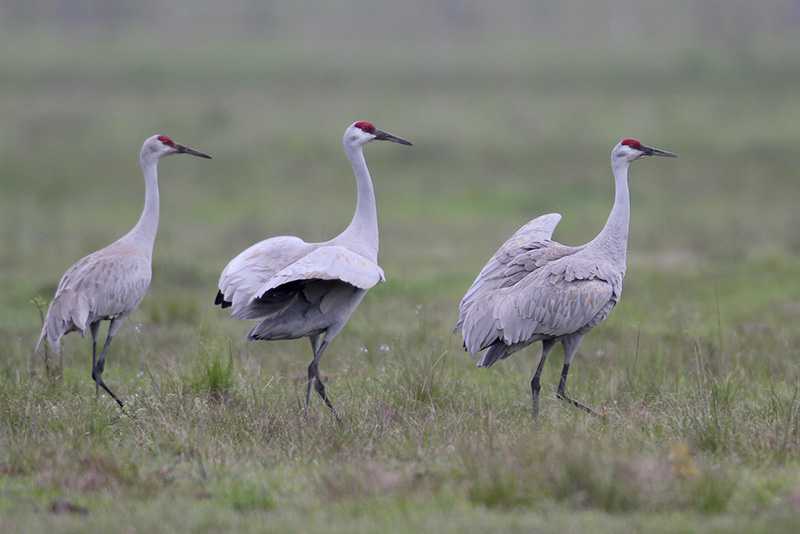The Sandhill Crane is a huge bird. They have long legs, very wide wings, and long necks. Their bodies are relatively bulky, which taper into their slender necks.
They have short tails that are covered by drooping feathers. Their heads are small, and they have bills that are longer than their head and straight.
These birds like to inhabit open areas. This means they’re pretty easy to find if you know where to look.
In summer, look for Sandhill Cranes in marshes, prairies, and small bogs, across the southeastern United States and the northern portions of North America. In winter, Sandhill Cranes form large flocks.
Their calls are unique and can be heard from miles away.
On this page
Breeding Male
Breeding male Sandhill Cranes are mostly slate gray and have a rusty tint on their upper parts. In addition, they have black legs, pale cheeks, and red skin on their crowns.
The Sandhill Crane has a length of 47.2 inches (120 centimeters), weigh 119.9 to 172.8 ounces (3400 to 4900 grams), and has a wingspan of 78.7 inches (200 centimeters).
They’re smaller than a Whooping Crane but are bulkier but about the same size as a Great Blue Heron.
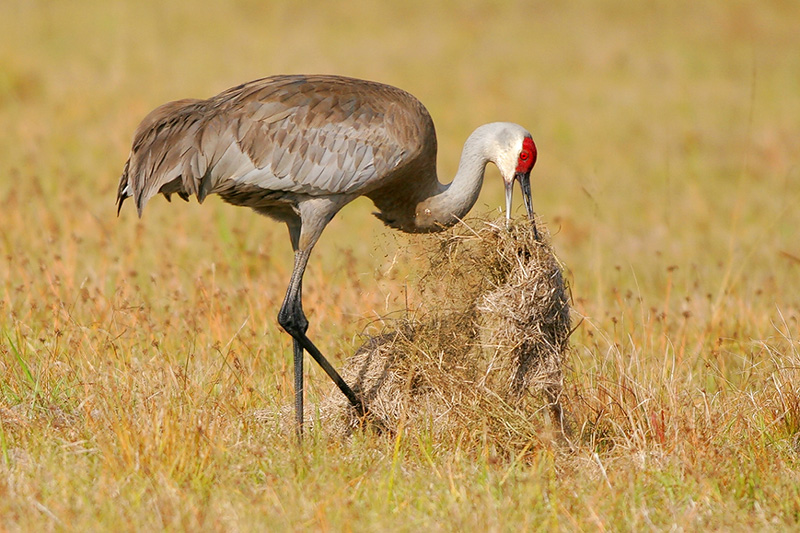
Some show a brown-stained appearance. Photograph © Greg Lavaty.
Female
Female Sandhill Cranes look identical to breeding male Sandhill Cranes. They’re mostly slate gray and have a rusty tint on their upper parts.
They have black legs, pale cheeks, and red skin on their crowns. They’re the same size and length and have the same wingspan as breeding males. They also weigh the same amount.
Juvenile
Juvenile Sandhill Cranes are rusty brown and gray. They lack the pale cheek and red crowns that adults have. It takes 32 days for these birds to hatch, and they’ll stay with their parents for 9 to 10 months.
Once these birds hatch, they’ll leave the nest within 24 hours. Then, they’ll follow their parents into the marsh. They’ll experience their first flight in around 65 to 75 days and will accompany their parents during migration.
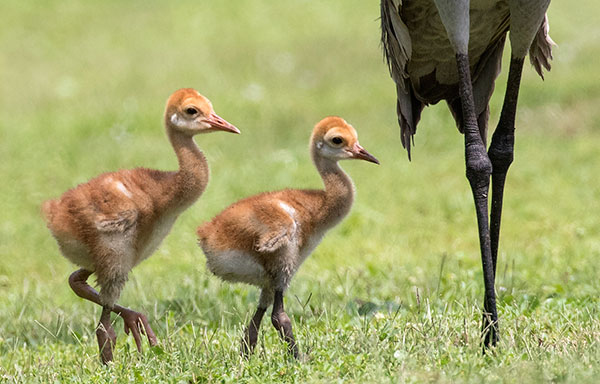
Habitat
Sandhill Cranes will breed in open wetlands that have trees or shrubs. They’ll build their nests in bogs, marshes, wet meadows, aspen stands that are burned over, prairies, and other habitats with moisture.
Breeding Sandhill Cranes will lean near the edges of upland habitats and wetlands, while nonbreeding Sandhill Cranes will lean toward grassy, open sites. Sandhill Cranes spend the winter in northern Mexico and the southern portions of the U.S.
They’ll roost on rivers or shallow lakes during the night and will spend the day in pastures, irrigated croplands, wetlands, and grasslands.
Diet
Sandhill Cranes are omnivores. They’ll feed in marshes that are shallow, where aquatic plants grow or on land. They’ll glean from the surface and probe with its bill.
Their diet is heavy in cultivated grains and seeds, but they’ve also been known to consume tubers, invertebrates, small vertebrates, and berries.
Nonmigratory Sandhill Crane populations will consume larval and adult insects, reptiles, snails, amphibians, small mammals, nestlings, berries, and seeds.
Behavior
Sandhill Cranes are birds that mate for life. They choose their lifelong partner based on their mating display which involves dancing. When courting, Sandhill Cranes will pump their heads, stretch their wings, jump into the air, and bow.
Females usually lay 2 eggs, and only 1 nestling usually survives to fledge. Mated pairs and their young hatchling will stay together through the entirety of winter until the juvenile turns 9 to 10 months old.
Related: Bird Quotes To Make Your Day Brighter
During the winter and migration, families will group up with other families and nonbreeding birds. This forms loose feeding and roosting flocks. These flocks can have tens of thousands of Sandhill Cranes.
Sandhill Cranes will attack predators in the air by jumping into the air and kicking with their feet. In addition, they threaten ground predators by hissing, spreading their wings, and even kicking.
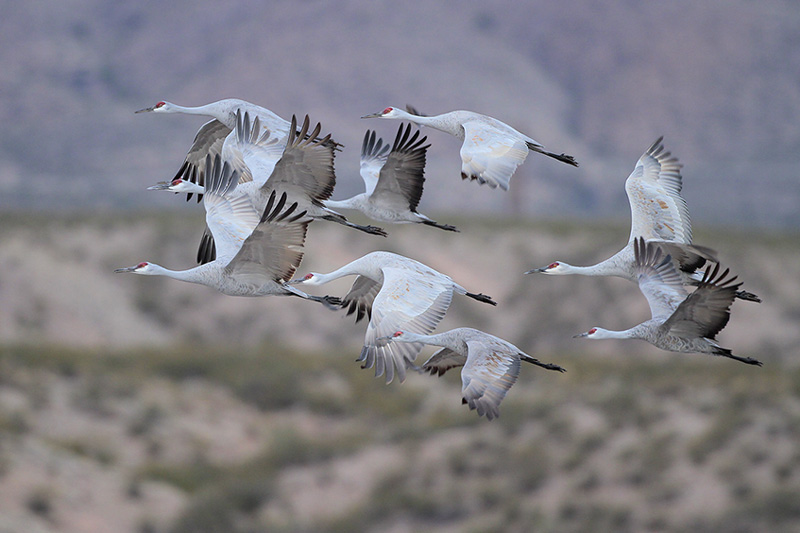
Sandhill Cranes
Range (and seasonal changes)
There are resident Sandhill Cranes as well as long-distance migrant Sandhill Cranes. There are 3 subspecies that live in Mississippi, Florida, and Cuba year-round. In addition, 3 other subspecies migrate from the northern portions of North America to northern Mexico and the southern United States.
Wing shape
Sandhill Cranes have very wide wings; their wingspan can be anywhere from 5 feet 5 inches to 7 feet 7 inches. Their huge wingspan makes them excellent at soaring. In addition, these birds can ride thermals for long periods of time without having to flap their wings. Doing this saves them a lot of energy.
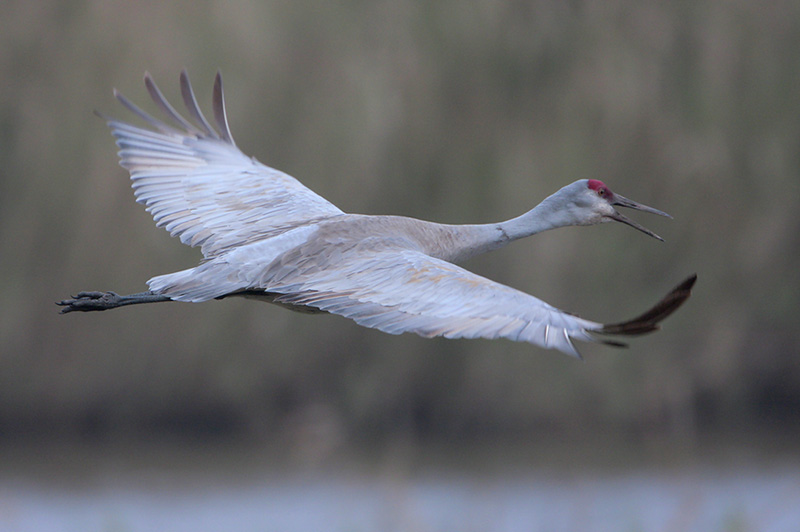
Sandhill Crane
Fun Facts
- Sandhill Cranes make great spirit animals. They’re considered noble birds that signify good luck, grace, and prosperity.
- 75 percent of the Sandhill Crane population can be found along a 75-mile stretch of the Platte River in Nebraska during migration.
- Sandhill Cranes are birds that mate for life. They choose their lifelong partner based on their mating display which involves dancing. When courting, Sandhill Cranes will pump their heads, stretch their wings, leap into the air, and bow.
- Sandhill Cranes can travel more than 200 miles a day when migrating. They’re also swift fliers and can reach speeds of up to 35 miles per hour.
Vocalization
Sandhill Cranes make rattling, loud bugle calls. These calls are often strung together and will last a couple of seconds. Amazingly, these calls can be heard up to 2.5 miles away.
They’ll make these vocalizations both in the air and on the ground. Other vocalizations these birds will make are hisses, moans, snoring sounds, and gooselike honks. Sandhill chicks will make purrs and trills.
Frequently Asked Questions About Sandhill Cranes
How rare is it to see a Sandhill Crane?
No, it’s not rare to see Sandhill Cranes. These birds have an extensive range and healthy populations.
What is special about Sandhill Cranes?
Sandhill cranes are opportunistic feeders. This means that they change their diet based on what’s available in the habitat they’re in.
What does a Sandhill Crane look like?
Sandhill Cranes are mostly slate gray and have a rusty tint on their upper parts. In addition, they have black legs, pale cheeks, and red skin on their crowns.
How big is a Sandhill Crane?
Sandhill Cranes are very large birds. These birds can be 3 to 4 feet tall and have wingspans of 5 feet 5 inches to 7 feet 7 inches.
Where do Sandhill Cranes live?
Sandhill Cranes will breed in open wetlands that have trees or shrubs. They’ll build their nests in bogs, marshes, wet meadows, burned-over aspen stands, prairies, and other habitats with moisture—Sandhill Cranes winter in northern Mexico and the southern portions of the U.S.

